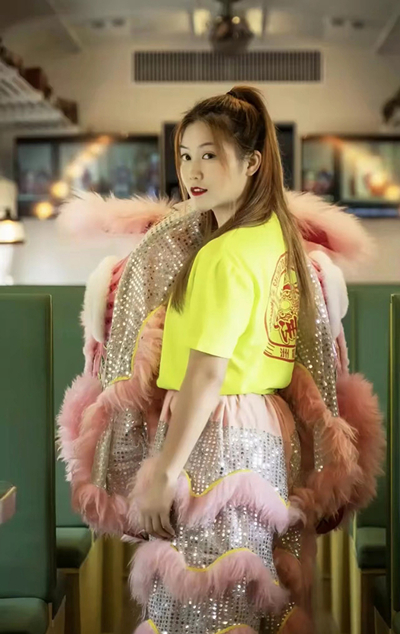|
||||||||||
| Home Nation World Business Opinion Lifestyle ChinAfrica Multimedia Columnists Documents Special Reports |
|
||||||||||
| Home Nation World Business Opinion Lifestyle ChinAfrica Multimedia Columnists Documents Special Reports |
| ChinAfrica |
| A Passion For an Unusual Art |
| A female artist is committed to mastering the male-dominated art of high-pole lion dance |
| By Deng Di 丨VOL. 15 May 2023 ·2023-04-19 |

Instead of the traditional redyellow-black lion dance costume, Liang Jiali prefers wearing more fashionable coloured costumes like this pink one
Lion dance is a popular folk activity in China, and is traditionally associated with joyful celebrations since it is thought to bring riches and good fortune. Dancers in lion costumes jump back and forth while integrating Chinese martial arts and acrobatics to the sounds of drums, cymbals, and resounding gongs. Such performances draw huge crowds, which always adds to a joyous mood.
Lion dancer Liang Jiali, 28, from Foshan City in south China’s Guangdong Province, carries the ancient tradition on poles of various heights. She was chosen at the age of seven to join the only elite women’s team in China, the Shunde Women’s Lion Dance Troupe. She has been attached to the male-dominated art genre for 21 years now.
Resuming an interrupted career
High-pole lion dance was introduced and promoted in Nanhai of Foshan City in the 1990s. It follows rules that are different from the classic lion dance: Instead of tapping on the ground, participants use circular platforms elevated on poles that are between 1 and 3 metres high. The size and placement of the platforms vary. The poles are often set up where dancers’ skills could be demonstrated while at the same time the audience can enjoy a safe and satisfying watching experience. The art is more challenging and riskier due to the coordination and balance required to mimic the fearsome lion.
Liang developed a love for this art in elementary school. She was fascinated by the image of young women whirling defiantly and skilfully around poles. But it wasn’t until she began training that she realised how difficult and dangerous it was. She still recalls the trainer asking her to jump from one pole onto another at a distance of 1.6 metres on the first day.
The daily workouts are intense and involve jumping in addition to leg exercises, sprinting, and weightlifting, much like acting in the kungfu movies. It is normal to fall down when exercising. Liang stopped wearing skirts and shorts after an incident so that her scars would not be visible. “Injuries are inevitable for an athlete, and every time I see these scars, I see my dreams again,” she said. “The lowest pole was 1.4 metres tall, and the highest was 3 metres. I had multiple fractures in my left leg after a fall from a 2-metre pole. I was in pain for a whole month.”
Liang and her teammates often went out to compete with their male counterparts when performing with Shunde Women’s Lion Dance Troupe, and they triumphed in many competitions. Their coach retired in December 2010, and the troupe was disbanded.
Liang had to find alternative means of support. She experienced financial problems from 2011 to 2017 when she was unable to perform. She wanted to keep practicing, but there was no rehearsal location. She remembers having a talk with a former colleague who also missed the lion dance. She wanted to get back to performing at all costs.
She and one of her former teammates Huang Baoyi started off by performing in small commercial shows, and did some part-time jobs in male lion dance troupes. A once-in-a-lifetime chance eventually came in 2019. After witnessing their impressive performance, Li Peikun, head coach of the Lunjiao Sanzhou Dragon and Lion Troupe, hired them into a new performing group. They started to have more chances to practice and compete.

At the 16th Games of Guangdong Province in August 2022, Liang Jiali (left front) and her colleagues take part in the Dragon and Lion Dance contests
Unparalleled beauty
In this type of lion dance, the poles are positioned to mimic mountains, streams, zip lines, and bridges. The dancers must do dazzling manoeuvres that incorporate martial arts, dancing, acrobatics, and gymnastics to portray the lion’s emotions, such as delight, fury, and exaltation.
Reflecting on her experiences during the previous several years, Liang noted that few women participate in lion dance professionally in China, where the sport is still dominated by men. In addition to overcoming physical challenge and the fear of jumping between poles at elevated locations, they also have to overcome many social prejudices compared with their male counterparts.
Male troupes are given a priority for commercial reasons. In the past, some men would boast about their dominance in the tournaments and even joke that their female competitors had little chance of winning. Once, even a judge asked why she and her teammates did not choose simple actions. More than this, not all her family members were supportive of her, especially her father. Whenever she came home with injuries incurred during lion dancing, some of her family members would always try to persuade her to engage in something less dangerous and “more suitable for young women.”
But Liang said that to her, lion dancing was never gender specific, and she found her family’s reasoning unconvincing. “I wanted to highlight how much women can achieve, and to combat the discrimination that exists in the workplace,” she said, adding that the first generation of women to perform lion dance was that of Mo Guilan, the wife of renowned Chinese martial artist Huang Feihong (1847-1924), and that nowadays, there is much more gender equality in the cultural field.
To improve her technical abilities, she practiced nonstop and observed the motions of lions, cats, and other animals.
Keeping the tradition
Liang, who has roughly 150,000 followers on the Chinese short video platform Douyin, adopted the nickname “High-Pole Lion Girl” for herself. There, she posts videos of her daily workouts and performances, both with and without her colleagues. More information about high-pole lion dance has spread throughout China and beyond, inspiring some women to take up the activity.
She designed her own blue and white lion head, which many supporters believed to be associated with a special type of “filial lion” that only shows up at sacrificial occasions, in an effort to draw in more young people. Liang believes that blue and white are more dynamic colours for young people like her than the conventional yellow, red, and black lion heads.
In addition, she has also tried to make lion dancing more visible. Apart from performing at the grand openings of shopping malls or celebrations, she and her teammates have performed at scenic spots to demonstrate classical lion dance movements to draw people’s attention. They have also made cultural products as a way of promoting public awareness of the art.
“For me, the lion dance is similar to a belief. I remember that when my dancing troupe was disbanded in 2010, a close family member passed away the same year. I was depressed. Yet every time I watched the lion dance, even when I was at my lowest point, I would feel very energised. I am trying to find more successors to continue the lion dance while cherishing the job I now have,” she said.
| About Us | Contact Us | Advertise with Us | Subscribe |
| Copyright Beijing Review All rights reserved 京ICP备08005356号-5 京公网安备110102005860号 |